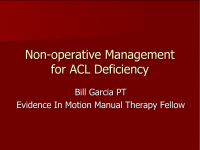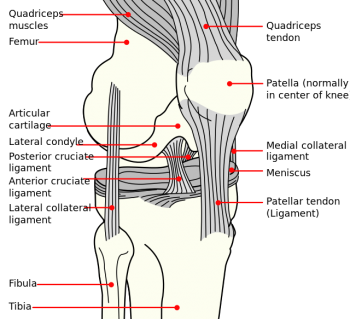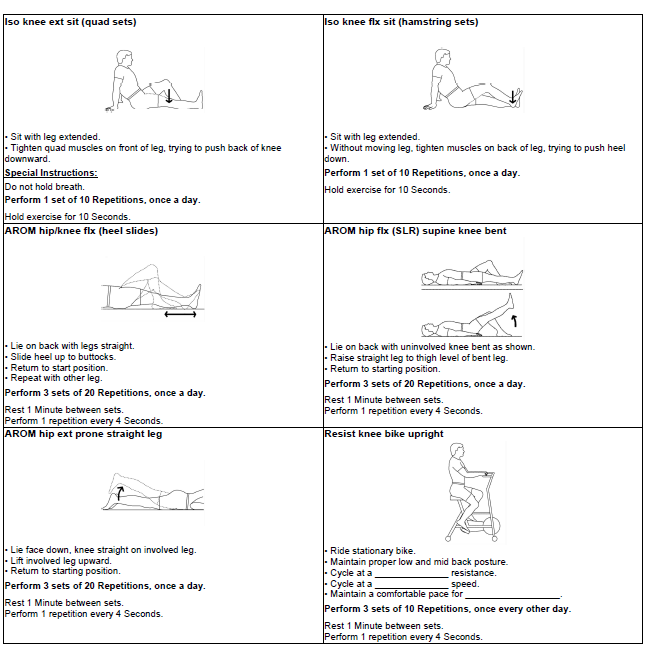Anterior Cruciate Ligament (ACL) Rehabilitation
Original Editors - Rachael Lowe Lieselot Longe
Top Contributors - Laura Ritchie, Riccardo Ugrin, Admin, Lieselot Longe, Evan Thomas, George Prudden, Habibu Salisu Badamasi, Kim Jackson, Tony Lowe, Scott Buxton, Claire Knott, Tarina van der Stockt, Bisoffi, Ilkje De Vlieger, Falcone Tseng, Naomi O'Reilly, Ines Corthals, Saeed Dokhnan, WikiSysop, Simisola Ajeyalemi, 127.0.0.1, Rucha Gadgil, Wanda van Niekerk, Jess Bell and Aminat Abolade
Definition/Description[edit | edit source]
ACL rehabilitation has undergone considerable changes over the past decade. Intensive research into the biomechanics of the injured and the operated knee have led to a movement away from the techniques of the early 1980's characterized by post operative casting, delayed weight bearing and limitation of ROM, to the current early rehabilitation program with immediate training of ROM and weight bearing exercises[1] (Level A).
The major goals of rehabilitation of the ACL-injured knee:
- Gain good functional stability
- Repair muscle strength
- Reach the best possible functional level
- Decrease the risk for re-injury
Closed kinetic chain exercises (CKC) and Open kinetic chain exercises (OKC) play an important role in regaining muscle (quadriceps, hamstrings) strength and knee stability.
Closed kinetic chain exercises have become more popular than Open kinetic chain exercises in ACL rehabilitation. Clinicians believe that CKC exercises are safer than OKC exercises because they place less strain on the ACL graft. Besides, they also believe that CKC exercises are more functional and equally effective as OKC exercises[3] (Level A).
Clinically Relevant Anatomy
[edit | edit source]
Please see these pages for relevant anatomy: Anterior Cruciate Ligament (ACL) and Anterior Cruciate Ligament (ACL) - Structure and Biomechanical Properties
General Considerations[edit | edit source]
Acute Stage[edit | edit source]
After ACL injury, regardless of whether surgery will take place or not, physiotherapy management focuses on regaining range of movement, strength, proprioception and stability.
PRICE should be used in order to reduce swelling and pain, to attempt full range of motion and to decrease joint effusion.
Exercises should encourage range of movement, strengthening of the quadriceps and hamstrings and proprioception. Consider integrating any of these exercises into a rehabilitation programme at this stage as is appropriate for the client:
- SQs/SLR
- ankle DF/PF/circumvention
- Knee flexion/extension slides in sitting
- Patellar mobilisations
- Glut Med work in side lying
- Gluteal exercises in prone
- Knee flexion in prone (gentle kicking exercises)
- weight transfers in standing (forwards/backwards, side/side)
NMES combined with exercise is more effective in improving quadriceps strength than exercise alone[1].
Also consider taping to provide stability and to encourage reduction in swelling.
Before Surgery[edit | edit source]
RICE and electrotherapy can be applied during several weeks ahead of the surgery in order to reduce swelling and pain, to attempt full range of motion and to decrease joint effusion. This will help the patient to regain better motion and strength after the surgery.[2]
Pre-op therapy should encourage strengthening of the quadriceps and hamstrings. Range of motion exercises should be included if there is no pain involved.[3][4] See below for examples of appropriate exercises.
NMES combined with exercise is more effective in improving quadriceps strength than exercise alone[1].
After Surgery[edit | edit source]
- Week 1
Regular icing and elevation are used to reduce swelling. The goal is full extension and 70 degrees of flexion by the end of the first week. The use of a knee brace and crutches are imperative.
Multidirectional mobilizations of the patella should be included for at least 8 weeks. Other mobilization exercises in the first 4 weeks are passive extension of the knee (no hyperextension) and passive and active mobilization towards flexion. Strengthening exercises for the calf muscle, hamstring and quadriceps (vastus medialis) can be performed.
- Week 3-4
The patient must trie to genuinely increase the stance phase in an attempt to walk with one crutch. With good hamstring/quadriceps control, the use of crutches can be reduced earlier.
- Week 5
The use of the knee brace is progressively reduced.[2][3] Passive mobilizations should normalize motility but flexion should not yet be thorough. 9 Tonification of hamstrings and quadriceps (vastus medialis) can start in close chain exercises. The exercises should be started on light intensity (50% of maximum force) and progressively increased to 60-70%. The closed chain exercises should be built from less responsible positions (bike, leg presses, step) to more congested starting positions (ex.squad). The progress of the exercise depends on pain, swelling and quadriceps control. Proprioception and coordination exercises can start if the general strength is good. This includes balance exercises on boards and toll.
- Week 10
Forward, backward and lateral dynamic movements can be included as well as isokinetic exercises.[3]
- Month 3
After 3 months, patient can move on to functional exercises as running and jumping. As proprioceptive and coordination exercises become heavier, quicker changes in direction are possible. To stimulate coordination and control through afferent and efferent information processing, exercises should be enhanced by variation in visible input, surface stability (trampoline), speed of exercise performance, complexity of the task, resistance, one or two-legged performance, etc.[3]
- Month 4-5
Final goal is to maximize endurance and strength of the knee stabilizers, optimize neuromuscular control with plyometric exercises and to add the sport-specific exercises. Acceleration and deceleration, variations in running and turning and cutting manoeuvers improve arthrokinetic reflexes to prevent new trauma during competition.[4]
Open versus Closed Kinetic Chain Exercise[edit | edit source]
www.physio-pedia.com/index.php
1. Open-Kinetic-Chain exercises:[edit | edit source]
1.1. Characteristics
- Non-weight bearing
- Movement occurring at a single joint
- Distal segment free to move
- Resistance is usually applied to the distal segment
1.2. Open-Kinetic-Chain Knee-Extension exercises
These exercises have a limited role in ACL rehabilitation programs, because research showed that OKC-extension exercises from 60° to 0° flexion, markedly increase anterior tibial translation in the ACL-deficient knee, as well as ACL graft strain in the reconstructed knee[2](Level 2B).
Despite these findings, OKC-extension exercises aren’t excluded in ACL-rehabilitation programs, because the same research has shown that OKC-extension exercises from 90° to 60° of flexion could be done safe, without increasing anterior tibial translation or ACL graft strain[2] (Level 2B).
In short, OKC-extension exercises in ACL rehabilitation programs could be done safe in a ROM from 90° to 60° flexion and are furthermore useful to train the quadriceps isolated.
1.3. Open-Kinetic-Chain Knee-Flexion exercises
OKC-flexion exercises play an important part in the rehabilitation process because research showed that there is no anterior tibial translation or ACL graft strain during these exercises. Besides, they result in isolated hamstrings muscle contraction[10] ( Level 2B).
2. Closed-Kinetic-Chain Knee exercises:[edit | edit source]
2.1. Characteristics
- Weight bearing
- Movement at several joints
- Distal segment fixed to a surface
- Resistance may be applied both proximally and distally
2.2. Closed-Kinetic-Chain Knee exercises
CKC-exercises play an important role in ACL-rehabilitation because they result in a hamstrings-quadriceps co-contraction that reduces tibiofemoral shear forces. Besides, research showed that during CKC-exercises body weight provides tibiofemorale joint compression, that also reduces tibiofemoral shear forces [7] (Level A).
CKC exercises have several advantages compared with OKC exercises[12] (Level F).
• Increase stability in the knee joint (more joint compression)
• Functional load
• Strong coordinative training
• Minimal shear force
• Less stress on the ACL
• No selective muscle training
• Weakest link in the chain is feeling the most "overload" and the corresponding largest trainings effect
• Fewer complications such as patellofemoral symptoms
• CKC-exercises are earlier to apply than OKC-exercises
3. Examples[edit | edit source]
3.1. Postoperative phase 1 ( 1-5 weeks)
- Exercises 1:
The first CKC-exercises are sitting exercises because they facilitate flexion and extension movements in the knee [9] (Level A).
The patient lying on a table has to extend the knee against resistance from a stretcher.
| [5] | [6] | [7] |
| [8] | [9] | [10] |
Return to Sport[edit | edit source]
| [11] |
Strength and power deficits after surgery may be a risk factor for future injuries and may set athletes up for failure when they try to return to their prior performance levels. Researchers suggest that the surgically repaired leg should perform at least 90% as well as the uninjured leg before you return to sport[12]. Three hopping tests can be used as part of a comprehensive physical and functional examination to help ensure not just a speedy, but a safe return to sport after ACL reconstruction. These 3 tests are sensitive enough to measure side-to-side differences and can be used during more advanced recovery phases after surgery to help ensure that the athlete’s exercise program is successful in returning the injured leg at least to the level of the uninjured leg[12].
When Should an Athlete Return to Sport After an ACL Surgery?
Rehab Protocols[edit | edit source]
Sport Specific Considerations[edit | edit source]
Suggestions From the Field for Return-to-Sport Rehabilitation Following Anterior Cruciate Ligament Reconstruction: Alpine Skiing[13]
Considerations[edit | edit source]
In a retrospective, cross-sectional analysis conducted by Culvenor et al.[14] 30% of patients had patellofemoral pain (PFP) 12-15 months following ALCR using a hamstring graft. Those who were 27 and older were 2.6 times more likely to report PFP. Patellofemoral cartilage lesions, mensical tears (both assessed by arthoscopy), pre-injury activity level, time from injury to surgery and sex were not predictors of post-operative PFP.
Those who had PFP did not have reduced range of movement but performed worse at hop distance and single leg tasks. Patients also reported significantly lower quality of life, poor returning sport attitudes and increased kinesiophobia.
PFP is important to consider as maladaptive, fear avoidance patterns of movement perpetuate pain and functional disability by lowering pain experience thresholds. The use of appropriate language during rehab and psychosocial interventions are recommended.
Late stage rehab ideas with specifics for the female athlete
Evidence for Open and Closed Chain Exercises[edit | edit source]
In one study there was found no difference in strain on the intact ACL between OKC and CKC exercises. Currently, ACL grafts may respond more like the intact ACL. Therefore they argue, both types of exercise could be done safe[2](Level 2B).
A study that examined the effect of OKC and CKC exercises on functional activity concludes that both open kinetic chain and closed kinetic chain programs lead to an equal long-term good functional outcome[4](Level A).
In another study, group 1 carried out quadriceps strengthening only with CKC while group 2 trained with CKC plus OKC exercises starting from week 6 after surgery. It seemed that the addition of OKC quadriceps training after ACL reconstruction results in a significantly stronger quadriceps without reducing knee joint stability at 6 months and also leads to a significantly higher number of athletes returning to their previous activity earlier and at the same level as before injury. The authors conclude that the combination of OKC and CKC exercises is more effective than CKC exercises alone[5](Level B).
A study that compared the amount of anterior tibial displacement in the ACL-deficient knee during (1) resisted knee extension, an OKC-exercise and (2) the parallel squat, a CKC-exercise, concluded that the ACL-deficient knee had significantly greater anterior tibial displacement during extension from 64° to 10° in the knee extension exercise as compared to the parallel squat exercise[8](Level 2B).
There is also a study who concluded that CKC-exercises are safe and effective and offer some important advantages over open kinetic chain exercises[6] (Level 1B).
Adjuncts[edit | edit source]
NMES - Neurotech's Kneehab XP Quadriceps Therapy System has been shown to significantly improve rehab following ACL reconstruction[15].
Presentations[edit | edit source]
 |
Non-Operative Management for ACL Deficiency
This presentation, created by Bill Garcia, as part of the Evidence in Motion OMPT Fellowship, discusses the current best evidence for non-surgical rehabilitation of ACL tears. Non-Operative Management for ACL Deficiency/ View the presentation |
Recent Related Research (from Pubmed)[edit | edit source]
Failed to load RSS feed from http://www.ncbi.nlm.nih.gov/entrez/eutils/erss.cgi?rss_guid=1xYNIuIh3tINBYzgykSu5dqc6vtp0_F3jgtsAmQ6fQblW1QMPk|charset=UTF-8|short|max=10: Error parsing XML for RSS
References[edit | edit source]
- ↑ 1.0 1.1 Kyung-Min KiM, Ted Croy, Jay HerTel, SuSan Saliba. Effects of Neuromuscular Electrical Stimulation After Anterior Cruciate Ligament Reconstruction on Quadriceps Strength, Function, and Patient-Oriented Outcomes: A Systematic Review. J Orthop Sports Phys Ther 2010;40(7):383-391.
- ↑ 2.0 2.1 I Eitzen, H Moksnes, L Snyder-Mackler, MA Risberg. Progressive 5-Week Exercise Therapy Program Leads to Significant Improvement in Knee Function Early After Anterior Cruciate Ligament Injury. Journal of Orthopaedic and Sports Physical Therapy 2010;40(11):705-722
- ↑ 3.0 3.1 3.2 3.3 S. van Grinsven, R. E. H. van Cingel, C. J. M. Holla, C. J. M. van Loon. Evidence-based rehabilitation following anterior cruciate ligament reconstruction. Knee Surg Sports Traumatol Arthrosc 2010; 18:1128–1144
- ↑ 4.0 4.1 Savio L-Y. Woo, Richard E. Debski, PhD, John D. Withrow, Marsie A. Janaushek. Biomechanics of Knee Ligaments. The American Journal of Sports medicine 1999;27:533 Cite error: Invalid
<ref>tag; name "Elf" defined multiple times with different content - ↑ Mike Henkelman. ACL Rehab Forum: Therapy - Week 1. Available from: http://www.youtube.com/watch?v=n5AG4eaTS-A [last accessed 04/10/14]
- ↑ Mike Henkelman. ACL Rehab Forum: Therapy - Week 3. Available from: http://www.youtube.com/watch?v=6fGhPKUI0Us [last accessed 04/10/14]
- ↑ Mike Henkelman. ACL Rehab Forum: Therapy - Week 5. Available from: http://www.youtube.com/watch?v=NbFzjZAri-w [last accessed 04/10/14]
- ↑ Mike Henkelman. ACL Rehab Forum: Therapy - Week 10. Available from: http://www.youtube.com/watch?v=uibgRUgKNeQ [last accessed 04/10/14]
- ↑ Mike Henkelman. ACL Rehab Forum: Therapy - Weeks 12-13. Available from: http://www.youtube.com/watch?v=V1hg7sBH67U [last accessed 04/10/14]
- ↑ Mike Henkelman. ACL Rehab Forum: Therapy - Week 15. Available from: http://www.youtube.com/watch?v=NR8pINSvlag [last accessed 04/10/14]
- ↑ Atlantic Physical Therapy Center. ACL level 4 Test. Available from: http://www.youtube.com/watch?v=dEdr3Of8tUk[last accessed 04/10/14]
- ↑ 12.0 12.1 Gregory D. Myer, Laura C. Schmitt, Jensen L. Brent, Kevin R. Ford, Kim D. Barber Foss, Bradley J. Scherer, Robert S. Heidt Jr., Jon G. Divine, Timothy E. Hewett.Utilization of Modified NFL Combine Testing to Identify Functional Deficits in Athletes Following ACL Reconstruction. J Orthop Sports Phys Ther 2011;41(6):377-387.
- ↑ Kokmeyer, D., Wahoff M., Myhern M. Suggestions From the Field for Return-to-Sport Rehabilitation Following Anterior Cruciate Ligament Reconstruction: Alpine Skiing. Journal of Orthopaedic &amp;amp;amp;amp;amp;amp;amp;amp;amp;amp;amp;amp;amp;amp;amp;amp;amp;amp;amp; Sports Physical Therapy, April 2012, 42(4):313-325.
- ↑ Culvenor AG, Collins NJ, Vicenzino B, Cook JL, Whitehead TS, Morris HG, et al. Predictors and effects of patellofemoral pain following hamstring-tendon ACL reconstruction. J Sci Med Sport. 2015.
- ↑ Sven Feil, John Newell, Conor Minogue and Hans H. Paessler. The Effectiveness of Supplementing a Standard Rehabilitation Program With Superimposed Neuromuscular Electrical Stimulation After Anterior Cruciate Ligament Reconstruction: A Prospective, Randomized, Single-Blind Study. Am J Sports Med February 22, 2011








